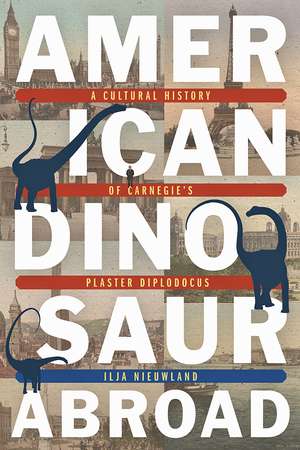American Dinosaur Abroad: A Cultural History of Carnegie's Plaster Diplodocus
Autor Ilja Nieuwlanden Limba Engleză Paperback – 22 sep 2020
In early July 1899, an excavation team of paleontologists sponsored by Andrew Carnegie discovered the fossil remains in Wyoming of what was then the longest and largest dinosaur on record. Named after its benefactor, the Diplodocus carnegii—or Dippy, as it’s known today—was shipped to Pittsburgh and later mounted and unveiled at the Carnegie Museum of Natural History in 1907. Carnegie’s pursuit of dinosaurs in the American West and the ensuing dinomania of the late nineteenth century coincided with his broader political ambitions to establish a lasting world peace and avoid further international conflict. An ardent philanthropist and patriot, Carnegie gifted his first plaster cast of Dippy to the British Museum at the behest of King Edward VII in 1902, an impulsive diplomatic gesture that would result in the donation of at least seven reproductions to museums across Europe and Latin America over the next decade, in England, Germany, France, Austria, Italy, Russia, Argentina, and Spain. In this largely untold history, Ilja Nieuwland explores the influence of Andrew Carnegie’s prized skeleton on European culture through the dissemination, reception, and agency of his plaster casts, revealing much about the social, political, cultural, and scientific context of the early twentieth century.
Preț: 126.00 lei
Nou
Puncte Express: 189
Preț estimativ în valută:
24.11€ • 25.78$ • 20.10£
24.11€ • 25.78$ • 20.10£
Carte disponibilă
Livrare economică 28 martie-11 aprilie
Preluare comenzi: 021 569.72.76
Specificații
ISBN-13: 9780822966524
ISBN-10: 0822966522
Pagini: 360
Dimensiuni: 152 x 229 x 25 mm
Greutate: 0.48 kg
Ediția:1
Editura: University of Pittsburgh Press
Colecția University of Pittsburgh Press
ISBN-10: 0822966522
Pagini: 360
Dimensiuni: 152 x 229 x 25 mm
Greutate: 0.48 kg
Ediția:1
Editura: University of Pittsburgh Press
Colecția University of Pittsburgh Press
Recenzii
“American Dinosaur Abroad is brisk, fascinating, and enormously informed. The topic demands a scholar of Ilja Nieuwland’s skills: he knows the languages; he understands the interplay of science, culture, politics, and the press; and he understands how, in human relations, personality is always the wild card. A must read for lovers of history and ancient bones.” —Tom Rea, author of Bone Wars: The Excavation and Celebrity of Andrew Carnegie’s Dinosaur
"Diplodocus is a Jurassic icon, one of the largest and most impressive dinosaurs ever uncovered. But it is not just that. In this detailed, thoughtful exploration, Ilja Nieuwland follows the changing cultural significance of this famous dinosaur in its role as ambassador, celebrity, and scientific catalyst, revealing how a single, spectacular skeleton can spur broader changes in the process of science and appreciation for nature. Read this book and you'll never look at old bones the same way again." —Brian Switek, author of My Beloved Brontosaurus and Skeleton Keys
“The story of Diplodocus is supposed to be familiar. But as revealed here by paleontological historian Ilja Nieuwland, the true story is more complex, nuanced, and interesting. His book is a crucial contribution to the sparse literature on historical paleontology and includes a vast amount of detail not previously covered elsewhere.” —Darren Naish, coauthor of Dinosaurs: How They Lived and Evolved
“Ilja Nieuwland has written a thoroughly researched and engaging account of the history of Diplodocus carnegii. American Dinosaur Abroad offers fascinating insight into the workings of international and national science in the early twentieth century and the growth of the iconic popularity of dinosaurs. A landmark work in the history of paleontology.” —Chris Manias, King’s College London
"The book is a story of science and history, but it's also a close reading of how fossils and their replicas become tools of capitalism, power, and privilege. And it's a story that Nieuwland tells particularly well. . . . American Dinosaur Abroad offers a well-researched example of how paleontological patronage ensured the scientific, social, and commercial success of a dinosaur. It's also a fascinating window into the idiosyncratic hubris of one of America's most consequential barons." —Pacific Standard
"Engaging and illuminating." —The Times Literary Supplement
“Nieuwland crafts appealing portraits of the narrative’s many characters, especially William J. Holland, the director of the Carnegie Museums and a lepidopterist turned self-trained paleontologist. . . . Extensive use of archives and sources in multiple languages result in thorough context for a global movement that involved much anatomical speculation and dueling expertise. Though it was not written in Nieuwland’s first language, the book’s prose is flawless.” —Foreword
“A prime example of simultaneously being highly engaging to read (and certainly accessible to a general reader), while also being a sophisticated and meticulously researched work in the history of science (utilizing collections in no less than 12 archives in six countries).” —Centaurus
Notă biografică
Ilja Nieuwland is a historian of science—in particular paleontology—attached to the Huygens Institute of the Royal Netherlands Academy of Arts and Sciences in Amsterdam.
Descriere
Explores the largely untold history of Andrew Carnegie’s prized skeleton through the dissemination, reception, and agency of his plaster casts in Europe and Argentina—dynamic objects that reveal much about the social, political, cultural, and scientific context of the early twentieth century.
